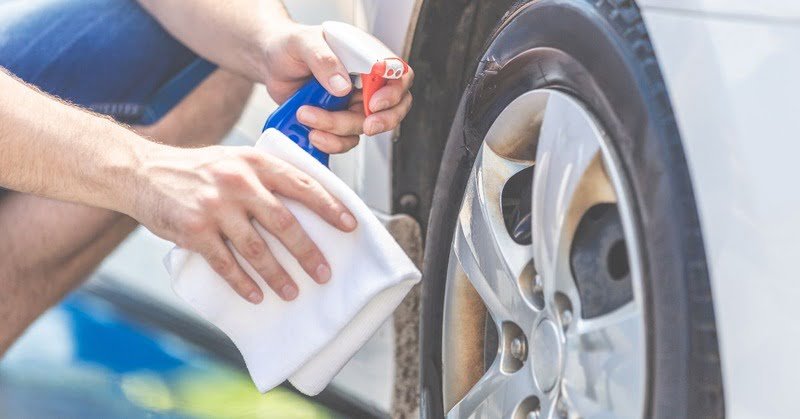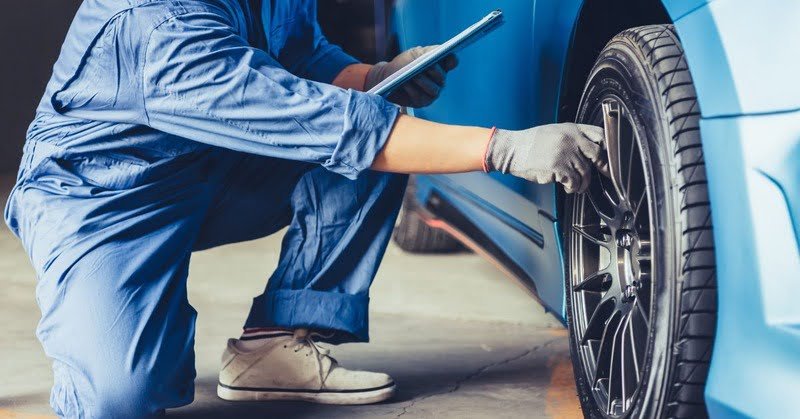Blog
How to Fix Curb Rash Using These 2 Simple Methods
Getting curb rash is never good for any car owner. It can lead to unwanted problems and cause headaches in the long run.
It doesn’t matter how small or big the rash is because, at the end of the day, you still have it, and you want it gone.
Well, don’t worry, because that’s where we come in.
In this guide, we’ll cover all you need to know about fixing this pesky curb rash problem and also provide tips on how to avoid it in the first place.
After you’re done reading, no bad scratch, dent, or any other damage that could result in a curb rash will ever come to your wheels again.
Let’s get into it!
How to Fix Curb Rash on Rims

To fix curb rash on rims, you can use a DIY wheel repair kit for minor damage, which involves cleaning, sanding, filling, and repainting the wheel, or opt for professional repair services for more severe damage. These services may include extensive techniques like media blasting and epoxy putty application. Both methods aim to restore the wheel’s appearance and integrity, with DIY being a cost-effective option and professional services offering expert solutions for complex repairs.
With that said, let’s dive into the full details on how to effectively fix one’s curb rash:
Table of Contents
Method 1: DIY Repair Using a Wheel Repair Kit
Step 1: Inspect the Damage
- Examine your wheels closely, focusing on the lip and other areas prone to curb rash.
- Identify the types of damage: surface scratches, paint scuffs, deep gouges, or bent rims.
Step 2: Gather Necessary Tools and Materials
- Prepare tools like rim cleaning solution, sandpaper (various grits), clear coat or touch-up paint, and a rubber mallet (for bent rims).
- Obtain a wheel repair kit, which typically includes filler, primer, and sometimes touch-up paint and a polishing compound.
Step 3: Clean and Prepare the Wheel
- Use the rim cleaning solution to thoroughly clean the wheel, ensuring the removal of all dirt, grime, and brake dust.
- Wear gloves and eye protection for safety.
Step 4: Sand the Damaged Area
- Start with coarse-grit sandpaper to sand down the damaged area, then progressively move to finer grits to smooth the surface.
- Use sandpaper included in the kit for consistency if provided.
Step 5: Apply Filler and Sand
- Use the filler from the kit to fill in scratches, dents, and scuffs.
- Ensure even and smooth application.
- After drying, sand the area again to ensure it blends seamlessly with the rest of the wheel.
Step 6: Painting and Repainting
- Apply primer (from the kit or your own supply) to the repaired area and let it dry completely.
- Paint the area using a color that matches your wheel. If the kit includes paint, use it; otherwise, use your own supply. Apply multiple thin coats for an even finish.
- After drying, apply a clear coat for a glossy finish and protection.
Step 7: Polishing and Finishing
- Use a polishing compound (either from the kit or your own) to polish the repaired area and restore the wheel’s shine.
- Consider applying wax for extra protection and shine.
- Optionally, apply a rim protector for long-term protection against future curb rash.
Step 8: Regular Maintenance
- Regularly inspect the wheel and reapply filler, paint, and clear coat as necessary to maintain the repair.
- Follow kit instructions for specific maintenance tips.
Additional Tips for a Successful Repair
- Always follow the specific instructions provided in the wheel repair kit for best results.
- If color matching is a concern, it may be worthwhile to consult with a professional for advice.
- Be patient throughout the process and allow adequate drying time between each step.
- Regular cleaning and protecting the wheel will prolong the life of the repair and maintain the wheel’s appearance.
RECOMMENDED: Car is Shaking After Hitting Curb
Method 2: Professional Repair

Professional repair is a practical option for car owners with curb rash, and shops generally offer two repair methods:
Refinishing Process
Suitable for minor damage, this method involves cleaning the wheel, sanding down the damaged area, applying putty for repairs, and repainting to match the original color. A clear coat is added for protection and shine.
Body Shop Method
Used for more severe damage, this approach includes media blasting the wheel to remove old paint, applying epoxy putty for deep repairs, and repainting for a fresh, new look.
How to Prevent Experiencing Curb Rash Again?
Alright. By this point, you might have already had your curb rash fixed and are looking for ways to avoid this problem entirely moving forward. Well, the methods below are what you can do to prevent experiencing curb rash ever again.
Implementing Defensive Driving Techniques

Awareness of Surroundings
Always be vigilant about your surroundings, especially in tight spaces like parking lots.
Careful Maneuvering
Take extra caution when parking near curbs or navigating through narrow spaces.
Slow Down Near Curbs
Reduce speed when approaching curbs to minimize the impact in case of accidental contact.
CONTINUE READING: Drove Over a Curb by Accident, What to Do?
Utilizing Parking Assistance Tools
Parking Sensors and Cameras
Leverage technology like backup cameras and parking sensors to gauge distance from curbs accurately.
Parking Guides
Use visual aids or parking guides in your garage to ensure consistent, safe parking away from potential hazards.
CONSIDER READING: What to Do When You’ve Hit a Curb on Your Car’s Front Passenger Side
Regular Vehicle Maintenance

Wheel Alignment Checks
Regularly check your car’s wheel alignment as misaligned wheels can increase the likelihood of curb rash.
CONSIDER READING: I Hit a Curb and My Wheel is Bent
Tire Pressure Monitoring
Maintain correct tire pressure to improve vehicle handling and reduce the chances of tire-to-curb contact.
Protective Accessories for Wheels
Rim Protectors
Install rim protectors that act as a buffer between your wheels and curbs.
High-Quality Wheel Coatings
Apply durable wheel coatings that can resist minor scratches and scuffs.
Modifying Parking Habits
Choosing Safer Parking Spots
Opt for parking spaces with ample room, away from tight corners or curbs.
Practicing Parallel Parking
Regularly practice parallel parking in a controlled environment to improve skills.
RECOMMENDED: Is It Bad to Park with Tire Against Curb?
Driver Education and Awareness

Understand Your Vehicle’s Dimensions
Familiarize yourself with the size and turning radius of your vehicle to better judge distances.
Defensive Driving Courses
Consider taking a defensive driving course to improve overall driving skills and spatial awareness.
Anticipating Road Conditions
Avoid Potholes and Obstructions
Be on the lookout for potholes, road debris, and other obstacles that could force you towards curbs.
TRY READING: What Causes Tire Bead Damage?
Adjust Driving in Bad Weather
Inclement weather can affect visibility and road grip, necessitating extra caution near curbs.
Mindful Customizations and Modifications
Careful with Vehicle Modifications
If you customize your vehicle, ensure that the modifications do not increase susceptibility to curb rash, like excessively wide rims.
Choose Appropriate Tires
Opt for tires with a design that offers some rim protection without compromising performance.
CONSIDER CHECKING: Can Hitting a Curb Damage Or Flatten My Tire?
Regular Wheel Inspections

Routine Checks for Early Detection
Regularly inspect wheels for any signs of damage that could be exacerbated by curb contact.
Professional Assessments
Have a professional periodically check your wheels and suspension for any issues that could lead to curb rash.
FAQs About Fixing Curb Rash
Let’s go through some questions you might have asked as we went along with our discussion of how to fix curb rash.
How often should I inspect my wheels for early signs of damage?
It’s recommended to inspect your wheels regularly, at least once a month, for early signs of damage like minor scratches or beginning signs of wear. This frequent inspection can help you address small issues before they turn into serious curb rash problems.
How do DIY repair kits compare to professional curb rash repairs?
DIY repair kits are suitable for minor curb rash repairs and can be cost-effective and convenient for superficial damage. However, for more extensive damage, professional repairs are recommended for a high-quality, durable repair that matches the original appearance of the wheel.
When should I consider professional help for curb rash repair?
Professional help should be considered for curb rash repair when the damage is severe, such as deep gouges, cracks, or significant bends in the wheel. Professional repair services have the necessary tools and expertise to restore the wheel safely and effectively.
ALSO READ: Does Insurance Cover Curb Damage?
Is there a difference in curb rash susceptibility between different wheel types?
Different wheel types can have varying susceptibility to curb rash. For example, alloy wheels are often more prone to visible damage like scratches and scuffs compared to steel wheels. However, any wheel type can suffer from curb rash under the right circumstances, so preventive measures are essential regardless of wheel type.
Are rim protectors worth investing in for curb rash prevention?
Rim protectors are a worthwhile investment for curb rash prevention. They provide a physical barrier between the wheel and the curb, absorbing impacts and preventing scratches and scrapes. While they may not prevent all forms of curb rash, they significantly reduce the severity of damage in case of contact with curbs.
Conclusion
If you’re still having trouble following the preventive measures we’ve discussed, then consider availing yourself of our product, Smooth Curb – Driveway Curb Ramp.
It’s designed to help you avoid those nasty curb hits near your driveway, and at the same time, pair it up by reading through our comprehensive guide on ‘How to Avoid Hitting Curbs‘, thus helping to ensure that you won’t experience curb rash ever again.
If you find value in what we’re advocating about curb rashes and similar topics, then do check out our blog where we discuss things such as ‘How to Drive a Lowered Car Up a Sloped Driveway‘, and ‘How Can You Fix a Steep Driveway?’, among others.
All in all, this comprehensive guide aims to help you fix and avoid curb rash for good.
Catering to both car owners interested in DIY tips and fixes, and those considering professional help – we here at Smooth Curb hope you’ve learned something new today, and we look forward to seeing you in our next post.
Always drive safe!

